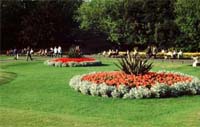Vacation Guide
Ireland golf vacation guide : To do and see
DUBLIN
 Book of Kells – situated in Trinity College, this is an 8th century manuscript containing the four Gospels written in Latin and decorated with many colourful and intricate designs. The Book of Kells is just one of the interesting artifacts on display in Trinity. Others include the Book of Durrow, Book of Armagh and a mediaeval harp.
Book of Kells – situated in Trinity College, this is an 8th century manuscript containing the four Gospels written in Latin and decorated with many colourful and intricate designs. The Book of Kells is just one of the interesting artifacts on display in Trinity. Others include the Book of Durrow, Book of Armagh and a mediaeval harp.
Christ Church Cathedral – has always beenan ecclesiastical site and the first church (a small wooden structure) was built here in 1038. Strongbow later developed the church into a stone structure, while a memorial to Strongbow can be seen in the cathedral’s nave. The cathedral’s crypt is the oldest intact building in Dublin, dating back to the original construction in 1172.
Dublin Castle – built between 1204 and 1224, there are few buildings in Dublin to rival Dublin Castle for longevity. It represented the seat of English power in Ireland until 1922, when the Irish Free State was established. The hading over of the castle was a tense historical moment and Michael Collins led the Irish army in taking over from the British garrison. When the commanding officer told Collins that he was 7 minutes late, Collins replied: "We’ve been waiting over 700 years, you can have the extra 7 minutes".
 Four Courts – home to Ireland’s highest courts of law, this impressive structure was completed in 1802. The Irish Civil War began here following the signing of the Anglo-Irish treaty in 1921, after which the building was occupied by those opposed to the treaty. Action was taken by the newly formed Irish government to remove them and the building was shelled and badly damaged by equipment lent to them by the British government.
Four Courts – home to Ireland’s highest courts of law, this impressive structure was completed in 1802. The Irish Civil War began here following the signing of the Anglo-Irish treaty in 1921, after which the building was occupied by those opposed to the treaty. Action was taken by the newly formed Irish government to remove them and the building was shelled and badly damaged by equipment lent to them by the British government.
General Post Office (GPO) – built between 1814 and 1818, it was enlarged over a 12-year period beginning in 1904. Reopened in March 1916, the building was quickly catapulted into the annals of Irish history. At Easter in 1916, it was seized by Irish revolutionaries who made it their headquarters for a violent attempt to establish independence from Britain. The rebellion was quickly put down; the leaders shot and the building itself badly damaged but the GPO will forever remain part of Irish history.
Grafton Street – this pedestrianised, cobbled thoroughfare has all the atmosphere of exclusive stores and the allure of talented street musicians, while a bronze statue of Molly Malone, heroine of the famous 19th century ballad, invites you to buy some cockles and mussels from her cart.
Guinness Hop Store – situated on Crane Street in a converted 19th century warehouse, the Hop Store offers a fantastic insight into the brewery’s operations and history. An audiovisual presentation on the history of Guinness is followed by a visit to the bar, where you will certainly sample one of the finest pints of stout you have ever tasted.
Kilmainham Gaol – decommissioned as a prison in 1924, it is still possible to experience some small sense of desperation that once dominated it. Throughout the course of history, many of Ireland’s political and military leaders have been incarcerated here, while 14 of the leaders of the 1916 rising were executed in the prison yard. Now a museum, there is a guided tour, an audiovisual presentation and an exhibition of archive material from the jail.
National Gallery of Ireland – situated on Merrion Square in the heart of Dublin City and open to the public since 1864, the gallery boasts an impressive collection of paintings from all the major European schools as well as a strong Irish collection.
National Museum – established in 1877, the museum houses many breathtaking exhibits, including a fine display of prehistoric gold artifacts and some remarkable works of early Christian art, such as the Ardagh Chalice and the Tara Brooch. Exhibits from the Viking age are also on view.
Old Jameson Distillery – Jameson Irish whiskey has been distilled here since 1780 and the visitor centre shows a detailed reconstruction of a working distillery. The guided tour, which is well worth taking, begins with an audiovisual presentation and finishes in the Jameson Bar with a complimentary glass of Ireland’s finest whiskey.
 St. Stephen’s Green – originally an enclosed park when the west side of Dublin City was used for hangings, this city centre park became popular with the aristocracy in the second half of the 18th century. The green offers a relaxing, pleasant open space in the heart of a busy, vibrant city centre.
St. Stephen’s Green – originally an enclosed park when the west side of Dublin City was used for hangings, this city centre park became popular with the aristocracy in the second half of the 18th century. The green offers a relaxing, pleasant open space in the heart of a busy, vibrant city centre.
Trinity College – founded by Queen Elizabeth in 1592, this is Ireland’s oldest university. Situated in the heart of Dublin, the college grounds were at the time of building, located just outside the original walled city, on a site that used to suffer from flooding when the River Liffey was at high tide.



